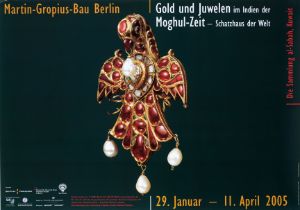Exhibition
Gold and Jewels in the India of the Mughal Era:
Treasury of the World. The al-Sabah Collection at Kuwait National Museum

Poster of the exhibition “Gold and Jewels in the India of the Mughal Era: Treasury of the World” Design: Steenbrink Vormgeving, Berlin
The unique pieces of jewellery made of gold and precious gems that are to go on view in Berlin were produced during the period when the Mughal, or Mogul, dynasty ruled in India. The Great Mughals is a Muslim dynasty which was at the height of its power in India from the middle of the 16th century to the beginning of the 18th century and left behind a strong influence on art and architecture. The splendid objects on display with their gemstones, weapons and jewellery finely worked with gold and silver are of overwhelming beauty. For a few months the Martin-Gropius-Bau will be turned into a treasure-house in the literal sense of the word.
The Kuwaiti collector Sheikh Nasser Sabah al-Ahmad al-Sabah is one of the leading collectors of Islamic art, and particularly jewellery, in the world. Sheikh Nasser has been building up the collection to be viewed in Berlin since the early 1970s. It demonstrates the unsurpassed skill of the craftsmen of that period and underscores the multifarious means of expression of Islamic art. The collection has been on long-term loan to the National Museum of Kuwait since February 1983.
Following the British Museum in London and the Royal Palace (Palacio Real) in Madrid, the Martin-Gropius-Bau is the third station of this world-famous collection in Europe and the only one in Germany.
Organizer: Berliner Festspiele in cooperation with the Museum of Islamic Art – State Museums of Berlin. The exhibition was organised by the “al-Sabah Collection” Dar al-Athar al-Islamiyyah, Kuwait National Museum. The exhibition was supported by Bankhaus Hauck & Aufhäuser Privatbankiers Frankfurt / Munich. With friendly support of Kuwait Petroleum International Limited and the Kuwait Petroleum Corporation.
Curators: Manuel Keene with Salam Kaukji
Venues: London: British Museum, Madrid: Palacio Real, Berlin: Martin-Gropius-Bau, Paris: Musée du Louvre